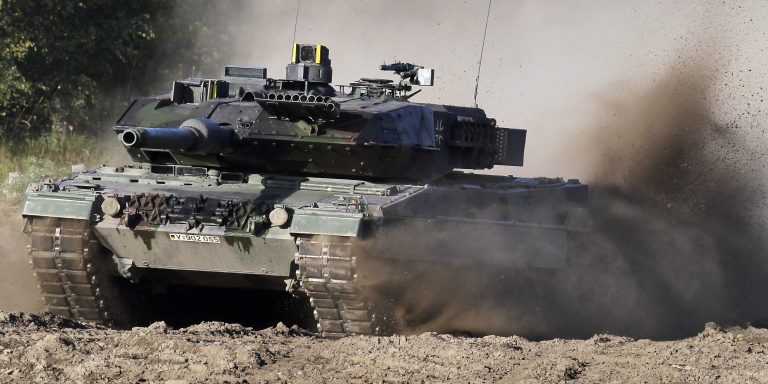INTELBRIEF
January 27, 2023
IntelBrief: Germany Releases the Leopards

Bottom Line Up Front
- Breaking months of deadlock, German Chancellor Olaf Scholz announced Germany and its allies will arm Ukraine with Leopard 2 tanks.
- Successive military aid packages to Ukraine continue to feature more sophisticated and in-demand systems, further committing Western powers to ensuring a Ukrainian victory.
- The Leopards are expected to be vital to disrupting a Russian offensive and/or supporting a Ukrainian counteroffensive.
- After Ukrainian President Volodymyr Zelenskyy’s cabinet shakeup over corruption concerns, demonstrating continued Western support may be as important as the tanks themselves.
German Chancellor Olaf Scholz announced Wednesday that Germany would arm Ukraine with Leopard 2 main battle tanks. The decision broke a months-long deadlock between Scholz and Western supporters of Ukraine and offers a significant material and psychological boost to the Ukrainian war effort. Scholz had faced intense international pressure, and his delay frustrated allies and Ukrainian leadership. Many of Scholz’s supporters prefer a pacifist German foreign policy, and the German population is split over whether to send Leopard tanks to Ukraine. After the Second World War and the partition that followed, Germany has sought to avoid conflict by engaging Russia economically and politically. To pressure Berlin and reassure Kyiv, the U.K. earlier this month promised to deliver 14 British-manufactured Challenger 2 tanks to Ukraine. Poland, which operates scores of German-made Leopards, had even threatened to transfer its tanks to Ukraine without Berlin’s approval. Following a series of painstaking public debates, Scholz finally acquiesced after the U.S. administration agreed to send 31 of its own M1 Abrams tanks. The drawn-out process suggests Germany may be unwilling to aggressively support Ukraine’s defense without the full weight of the trans-Atlantic alliance at its back.
Western security assistance to Ukraine has gradually increased in size and scope since the war began last February. Skeptical of Kyiv’s ability to defend against the Russian offensive and fearful of escalating the conflict beyond Ukraine’s borders, many countries which now staunchly support Ukraine’s campaign initially refused to provide it with heavy weaponry. After Ukraine demonstrated its resilience in the opening days of the war, Western powers flooded easy-to-use weapons that could make an instant impact on the battlefield to Ukraine. Over the summer, military aid packages to Ukraine grew more complex, lethal, and costly, beginning with the delivery of Western artillery and American-made high mobility artillery rocket systems (HIMARS). Each successive aid package has included more sophisticated and in-demand systems, improving Ukrainian capabilities while further committing Western powers to ensuring a Ukrainian victory. The reputational, monetary, and material costs for Ukraine’s partners have only made a Russian victory all the more undesirable, suggesting that the trend of increasingly potent military aid may continue for the foreseeable future.
Scholz’s announcement marks a breakthrough for several reasons. First, it authorizes Germany’s allies like Poland to re-export their own Leopards to Ukraine. Around two thousand of the tanks are currently in use or in storage across Europe, and Norway has already pledged its own delivery of Leopards. While it is unlikely that all of the continent’s supply of Leopards will end up in Ukraine, their widespread use on the continent will make crew training, vehicle maintenance, and resupply of ammunition and spare parts a joint effort, spreading the burden across several countries. In contrast, the U.K. will be the sole provider of training and vehicle sustainment for its Challenger 2. While the M1 is one of the most powerful tanks currently in use, its turbine engine is difficult to maintain and runs best on jet fuel, whereas the Leopard and Challenger both use more readily available diesel. All three tanks will benefit from a qualitative advantage over the older tanks currently deployed by Russia in Ukraine and are expected to be instrumental in disrupting an anticipated Russian offensive and/or supporting a Ukrainian counteroffensive. To realize the full benefit of the increasing volume of heavy weapons flowing into Ukraine, including American Bradley infantry fighting vehicles, Ukrainian armed forces will need to effectively integrate armor, infantry, artillery, and air assets in combined arms operations.
Since the beginning of the war, Ukrainian leadership has been desperate to replace its dwindling stock of Soviet-era tanks with more modern Western variants. This week’s announcements have been celebrated in Kyiv, but there is an understanding that the anticipated deliveries will take time before they can make an impact on the battlefield. After President Zelenskyy’s cabinet shakeup following corruption concerns, the West’s continued show of support is perhaps as important as the tanks themselves. Russian propaganda efforts had been quick to highlight Germany’s unwillingness to take the lead on Ukraine policy as a sign of divisions within NATO. After Scholz’s Leopard announcement, however, Kremlin officials dismissed the potential effect Western tanks might have on the war. Despite these minor squabbles, and the recent setback for Sweden and Finland’s NATO candidacy after a Quran was burned at a protest in front of Türkiye’s embassy in Stockholm, the alliance appears united in its commitment to supporting Ukraine’s war effort.
Now attention has shifted to France, as the next member of the alliance that could announce it will send its domestically produced tanks to Ukraine. Though another small batch of tanks with distinct logistical requirements will add to Ukraine’s sustainment challenges, Kyiv has proven itself more than capable of negotiating similar difficulties throughout the war. Whatever French President Emmanuel Macron elects to do, these recent developments have marked a dramatic shift in Germany’s approach to supporting Ukraine, leaving the door open for the delivery of even more powerful Western weapons to the battlefield.